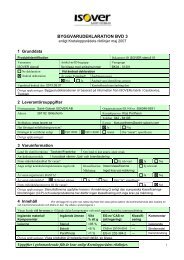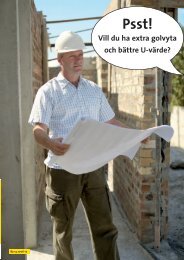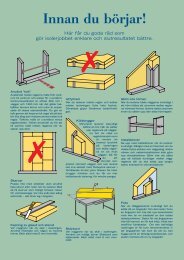ISOVER Passivhaus Engl.
ISOVER Passivhaus Engl.
ISOVER Passivhaus Engl.
Create successful ePaper yourself
Turn your PDF publications into a flip-book with our unique Google optimized e-Paper software.
The Ecological Import.<br />
From old bottles to welln<br />
What the industry and households<br />
discard as useless waste glass is<br />
turned by <strong>ISOVER</strong> into a valuable<br />
raw material. <strong>ISOVER</strong> glass wool<br />
consists by about 80 % of recycled<br />
waste glass. The other ingredients<br />
such as quartz sand, soda ash and<br />
limestone are virtually inexhaustible<br />
resources. This does not only sound<br />
but definitely is ecologically sustainable<br />
in many ways. Just a few<br />
examples may illustrate the point.<br />
122 <strong>ISOVER</strong><br />
The use of glass wool does not only<br />
help us meet the Kyoto target but<br />
also realize energy-efficient living<br />
all around the globe. Just consider:<br />
The production of 1 ton of glass<br />
wool releases about 0.8 t of CO2.<br />
The annual CO2 saving that can be<br />
realized by building in glass wool<br />
amounts to as much as 6 tons.<br />
Assuming a useful life of 50 years,<br />
we can thus save up to 300 t of CO2.<br />
And this is 375 times as much as the<br />
CO2 emission caused by production.<br />
<strong>ISOVER</strong> turns 1 m 3 raw material into 150 m 3 glass wool.<br />
Each built-in ton of glass wool insulation felt helps us<br />
save 6 tons of CO2 every year.<br />
This is sufficient to completely insulate a large one-family house from top to bottom in keeping with the passive<br />
house standard.<br />
1 m 3 raw material 150 m 3 glass wool









